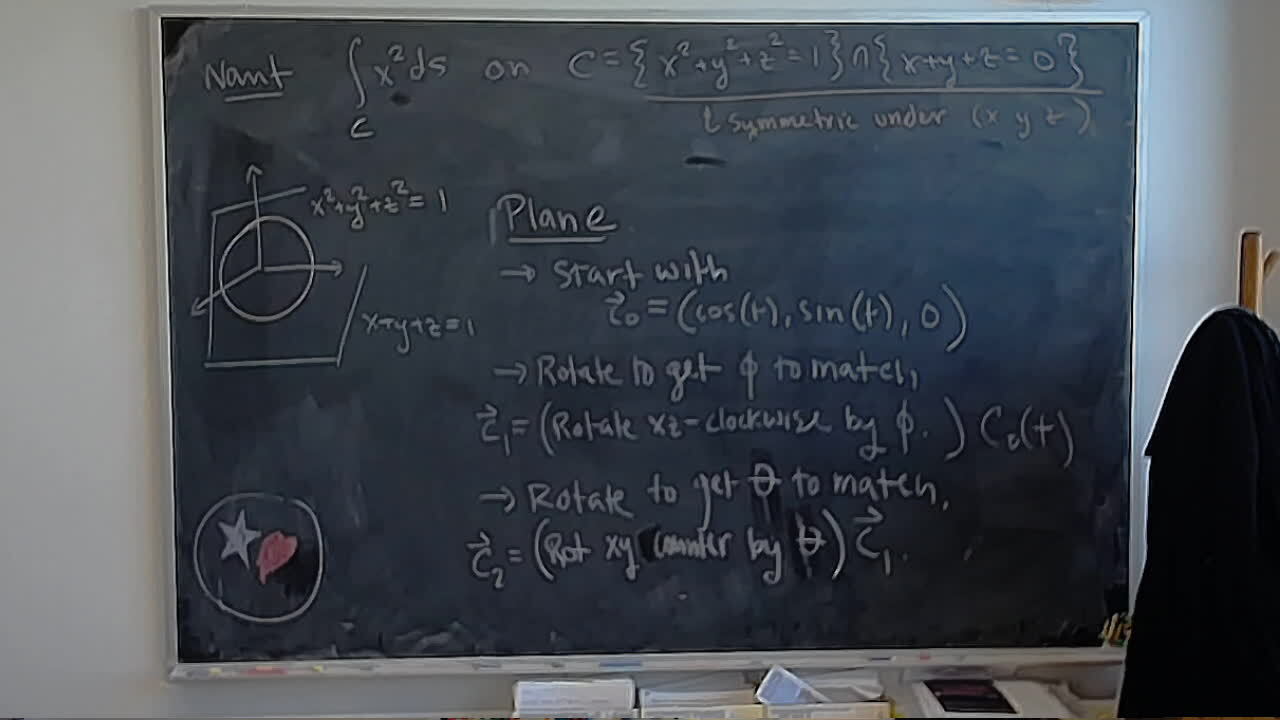

A student came to me asking about the intended solution of the integral shown on the top of the board. After playing around with the parametrization for a long while, we couldn’t get it to match the given curve. Our idea was: “Start with a circle in the plane and tilt it appropriately.”
This didn’t seem to work and we couldn’t figure out why. I asked my colleague Paco what as going on and he suggested that we approach it with spherical coordinates. The spherical coordinates of the normal $\mathbf{n} = (1,1,1)$ are $\theta = \pi/4$ and $\phi$ given by:
\[ \left\langle (1,1,1), (0,0,1) \right\rangle = \cos(\phi) \left\lVert (1,1,1) \right\rVert \left\lVert (0,0,1) \right\rVert \Longrightarrow \cos(\phi) = \frac{1}{\sqrt{3}} \]
I want to emphatical highlight the fact that $\phi$ is not a nice angle that you bump in to everyday. And yet, by the Pythagorean identity, we know:
\[ \cos(\phi) = \frac{1}{\sqrt{3}} \quad \quad \sin(\phi) = \sqrt{\frac{2}{3}}. \]
This suggests the following revised plan:
Putting the pieces together we get:
\[ \begin{array}{rcl} \mathbf{c}_2(t) & = & \begin{bmatrix} \cos(\theta) & \sin(\theta) & 0 \\ -\sin(\theta) & \cos(\theta) & 0\\ 0 & 0 & 1 \end{bmatrix} \begin{bmatrix} 1 & 0 & 0 \\ 0 & \cos(\phi) & \sin(\phi) \\ 0 & -\sin(\phi) & \cos(\phi) \\ \end{bmatrix} \begin{bmatrix} \cos(t) \\ \sin(t) \\ 0 \end{bmatrix} \\ & = & \begin{bmatrix} \frac{1}{\sqrt{2}} & \frac{1}{\sqrt{2}} & 0 \\ -\frac{1}{\sqrt{2}} & \frac{1}{\sqrt{2}} & 0\\ 0 & 0 & 1 \end{bmatrix} \begin{bmatrix} 1 & 0 & 0 \\ 0 & \frac{1}{\sqrt{3}} & \sqrt{\frac{2}{3}} \\ 0 & -\sqrt{\frac{2}{3}} & \frac{1}{\sqrt{3}} \\ \end{bmatrix} \begin{bmatrix} \cos(t) \\ \sin(t) \\ 0 \end{bmatrix} \\ & = & \begin{bmatrix} \frac{1}{\sqrt{2}} & \frac{1}{\sqrt{2}} & 0 \\ -\frac{1}{\sqrt{2}} & \frac{1}{\sqrt{2}} & 0\\ 0 & 0 & 1 \end{bmatrix} \begin{bmatrix} \cos(t) \\ \frac{1}{\sqrt{3}}\sin(t) \\ -\sqrt{\frac{2}{3}}\sin(t) \end{bmatrix} \\ & = & \begin{bmatrix} \frac{1}{\sqrt{2}} \cos(t) + \frac{1}{\sqrt{6}} \sin(t) \\ -\frac{1}{\sqrt{2}} \cos(t) + \frac{1}{\sqrt{6}} \sin(t) \\ -\sqrt{\frac{2}{3}}\sin(t) \end{bmatrix} \\ \end{array} \]
And you can check out the final curve on CalcPlot3D.
Published: Mar 17, 2025 @ 16:48.
Last Modified: Mar 21, 2025 @ 10:53.
Home / Now / Blog / Notes / Reading / Office Camera / Tags / Bookmarks / RSS Feeds / Top of Page
Thanks for reading! If you have any comments or questions about the content, please let me know. Anyone can contact me by email.